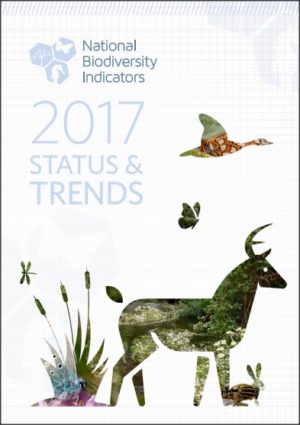The National Biodiversity Indicators: 2017 Status & Trends report is launched, designed to summarise trends in the health of our species, landscapes, and seascapes, as well as reflect broad changes in Irish society’s relationship with wildlife protection. The report can be downloaded directly from the dedicated website http://indicators.biodiversityireland.ie
Compiled by the National Biodiversity Data Centre from information provided by both governmental and non-governmental organisations, 62% of indicators show inadequate progress in delivering biodiversity conservation, 33% show progress has been made and another 5% are uncertain.
“As a society, the report shows that our awareness and knowledge of Irish wildlife is increasing and we’re beginning to take more affirmative actions to conserve Irish biodiversity,” said Dr. Tomás Murray from the National Biodiversity Data Centre, who co-ordinated the National Biodiversity Indicator project. But he added, “these societal changes are happening too slowly and the indicators demonstrate that more concerted action is needed if Ireland is to meet targets listed under the National Biodiversity Plan and international conservation targets set by the EU and the UN Convention on Biological Diversity.”
For the first time in Ireland, the National Biodiversity Indicators summarise biodiversity information from a variety of sources to support policy and decision making, reporting on progress towards national and international conservation targets, as well as providing a useful educational resource. Ireland is only the 5thcountry in the EU to develop and publish a suite of National Biodiversity Indicators.
The areas where Ireland still struggles to conserve nature include:
- 91% of Irelands habitats designated under EU law are of ‘inadequate’ or ‘bad’ status.
- The number high impact invasive alien species introduced into Ireland has increased by 183% from 1961 to 2010.
- Only 10% of Ireland’s 31,500 species have had their conservation status assessed. Of those, 3% are now extinct, 15% are assessed as under threat of extinction and 9% as near threatened.
However, the Indicators suggest that Ireland is beginning to show progress on the conservation of species protected under EU legislation, increased awareness about conservation and improved integration of environmental considerations into local and national decision making:
- For species protected under EU law, 53% species have a favourable conservation status.
- In an EU survey on public opinions on biodiversity, out of a 1,000 Irish people surveyed 95% agreed that our well-being and quality of life is based upon nature and biodiversity.
- Four Biodiversity Officers and 23 Heritage Officers with a biodiversity remit are now employed across 26 Local Authorities.
“At a time when biodiversity is under increasing pressure, it is essential that we have a broad-based set of national indicators that objectively can track how Ireland is doing on meeting its biodiversity commitments”, said Dr. Liam Lysaght, Director of the National Biodiversity Data Centre. “The challenge for the National Biodiversity Data Centre is to ensure that the evidence base for how biodiversity is changing is sufficiently detailed and robust to detect changes at the local and national level. This has become all the more important now, as we see the impact of climate change” he added.
Ireland is a signatory to the UN Convention on Biological Diversity (CBD) and is committed to the biodiversity goals and targets set out in the Convention’s Strategic Plan for Biodiversity 2011-2020. The 20 biodiversity targets, commonly known as the Aichi 2020 Biodiversity Targets, relate to the sustainable management and use of the world’s biological resources and cover a broad range of actions, including mainstreaming biodiversity conservation across government and society, and reducing pressures on biodiversity and promoting its sustainable use. To help focus conservation effort and support the development of evidence-based metrics to measure progress on achieving international biodiversity targets, the CBD-mandated Biodiversity Indicator Partnership was established in 2007 to provide guidance to nation states in developing national biodiversity indicators.
The indicators are under ongoing development and the current list will be reviewed in 2018 and aligned with Ireland’s 3rd National Biodiversity Action Plan published in October this year, and other multilateral environmental agreements such as the UN Sustainable Development Goals.










